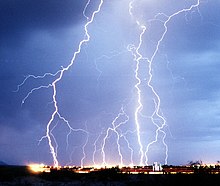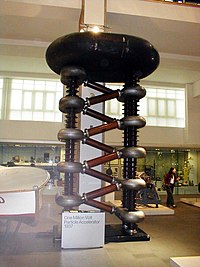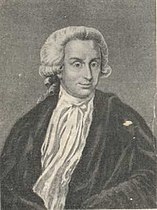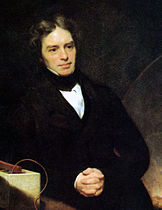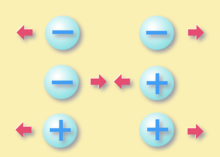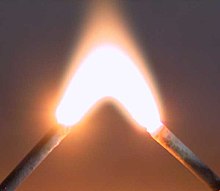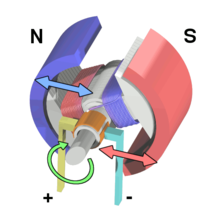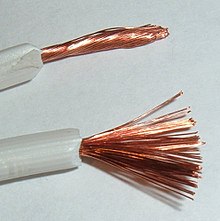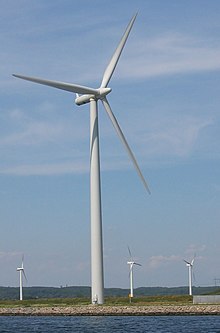Electricity
Electricity (from the Greek ήλεκτρον élektron, meaning 'amber') is the set of physical phenomena related to the presence and flow of electrical charges. It manifests itself in a wide variety of phenomena such as lightning, static electricity, electromagnetic induction or the flow of electric current. It is such a versatile form of energy that it has countless applications, for example: transportation, air conditioning, lighting and computing.
Electricity manifests itself through various phenomena and physical properties:
- Electric charge: a property of some subatomic particles, which determines its electromagnetic interaction. The electrically charged matter produces and is influenced by the electromagnetic fields.
- Electrical current: the flow of electrons circulating through a conductor at a certain time. It's measured in amperes.
- Electrical field: a type of electromagnetic field produced by an electric charge, even when it is not moving. The electric field produces a force in all other loads, the less the distance between the two loads. In addition, moving loads produce magnetic fields.
- Electrical power: it is the work that must perform an external force to attract a positive unitary charge that from the point of reference to the point considered, goes against the electric force and at constant speed.
- Magnetism: electrical current produces magnetic fields, and variable magnetic fields in time generate electric current.
History

The history of electricity refers to the study of electricity, the discovery of its laws as a physical phenomenon and the invention of artifacts for practical use. As also called electricity to the branch of science that studies the phenomenon and the branch of the technology that applies it, the history of electricity is the branch of the history of science and the history of technology that deals with its emergence and evolution. The phenomenon of electricity has been studied since ancient times, but its scientific study began in the centuries XVII and XVIII. At the end of the centuryXIXengineers managed to use it for domestic and industrial use. The rapid expansion of electrical technology made it the backbone of modern industrial society.
Long before there was any knowledge about electricity, humanity was aware of electric shocks produced by electric fish. Texts of Ancient Egypt dating from 2750 a. C. they referred to these fish as "the Nile Tronders", described as the protectors of the other fish. Subsequently, electric fish were also described by the Romans, Greeks, Arabs, naturalists and physicists. Ancient authors such as Plinio el Viejo or Largo Escribonio, described the burning effect of electric shocks produced by electric fish and electric stripes. In addition, they knew that these downloads could be transmitted by conductive matter. Patients with diseases such as gout and headache were treated with electric fish, hoping the discharge could cure them. The first approach to the study of lightning and its relation to electricity is attributed to the Arabs, which before the centuryXV They had a word for lightning.raad) applied to the electric strip.
In ancient cultures of the Mediterranean it was known that when scrubbing certain objects, such as an amber bar, with wool or skin, small loads (triboelectric effect) were obtained that attracted small objects, and scrubbing a long time could cause the appearance of a spark. Near the ancient Greek city of Magnesia were the so-called Magnesia stones, which included magnetite and the ancient Greeks observed that the pieces of this material were attracted to each other, and also to small objects of iron. The words magnet (equivalent in Spanish to magnetism) and magnetism derive from that toponymous. Towards the year 600 a. C.The Greek philosopher Tales of Mileto made a series of observations on static electricity. He concluded that friction had magnetism in the amber, as opposed to minerals such as magnetite, which did not need to be rubbed. Such was wrong to believe that this attraction produced a magnetic field, although later science would prove the relationship between magnetism and electricity. According to a controversial theory, births could have known the electrodeposition, based on the discovery in 1936 of the Baghdad battery, similar to a voltaic cell, although it is doubtful that the artifact was of an electric nature.
Such speculations and fragmentary records were almost exclusive treatment (with the notable exception of the use of magnetism for compass) that exists from Antiquity to the scientific revolution of the centuryXVII; although still then it was little more than a curiosity to show in the halls. The first contributions that can be understood as successive approximations to the electrical phenomenon were made as William Gilbert, who performed a careful study of electricity and magnetism. It differed the effect produced by bits of magnetite, of the static electricity produced by rubbing amber. In addition, he coined the term Neolatino electricus (which, in turn, comes from ・λεκτρον [chuckles]elektron], the Greek word for amber) to refer to the property of attracting small objects after having rubbed them. This originated the terms electric and electricityfor the first time in 1646 in the publication Epidemic Pseudodoxia Thomas Browne.
These studies were followed by systematic researchers such as von Guericke, Cavendish, Du Fay, van Musschenbroek (Bottle of Leyden) or William Watson. The observations submitted to the scientific method begin to bear fruit with Galvani, Volta, Coulomb and Franklin, and, already in the early nineteenth century, with Ampère, Faraday and Ohm. The names of these pioneers ended up baptizing the units used today to the extent of the different magnitudes of the phenomenon. The final understanding of electricity was achieved only with its unification with magnetism in a single electromagnetic phenomenon described by the equations of Maxwell (1861-1865).
The technological developments that produced the First Industrial Revolution did not make use of electricity. His first widespread practical application was Samuel Morse's electrical telegraph (1833)—preceded by Gauss and Weber, 1822—which revolutionized telecommunications. The industrial generation of electricity began from the fourth centuryXIX when the electric lighting of the streets and the houses spread. The growing succession of applications of this form of energy made electricity one of the main driving forces of the Second Industrial Revolution. More than great theorists like Lord Kelvin, it was the time of great engineers and inventors, such as Gramme, Tesla, Sprague, Westinghouse, von Siemens Graham Bell, and, above all, Alva Edison and his revolutionary way of understanding the relationship between scientific-technical research and capitalist market, which turned technological innovation into an industrial activity. The successive paradigm changes of the first half of the centuryXX. (relative and quantum) will study the function of electricity in a new dimension: atomic and subatomic.
The electrification was not only a technical process, but a real social change of extraordinary implications, beginning with the lighting and following by all kinds of industrial processes (electric motor, metallurgy, refrigeration...) and communications (telephony, radio). Lenin, during the Bolshevik Revolution, defined socialism as the sum of the electrification and power of the soviets, but it was above all the consumer society that was born in the capitalist countries, which depended more on the domestic use of electricity in the appliances, and it was in these countries where the feedback between science, technology and society developed the complex structures that allowed the current private R & D systems,
Electrical energy is essential to the information society of the third industrial revolution that has been taking place since the second half of the centuryXX. (transistor, television, computer, robotics, internet...) Only the oil-dependent motorization (which is also widely used, such as other fossil fuels, in the generation of electricity) can be compared to its importance. Both processes required increasing amounts of energy, which is at the origin of the energy and environmental crisis and the search for new sources of energy, most with immediate electricity (nuclear energy and alternative energies, given the limitations of traditional hydroelectricity). The problems that electricity has for long-distance storage and transportation, and for the autonomy of mobile devices, are technical challenges still unresolved sufficiently.
The Cultural Impact of What Marshall McLuhan Denominated Age of Electricitythat would follow the Age of Mechanization (compared to how the Metal Age followed the Stone Age), it lies in the very high rate of propagation of electromagnetic radiation (300 000 km/s) that makes it almost instantly perceived. This fact entails previously unimaginable possibilities, such as simultaneity and division of each process into a sequence. A cultural change was imposed that came from the focus on “specialized care” (the adoption of a particular perspective) and the idea of “an instantaneous sensitive consciousness of the whole”, a attention to the “total field”, a “feel of the total structure”. The sense of "form and function as a unit" became evident and prevalent, a "integrated idea of structure and configuration". These new mental conceptions had a great impact on all kinds of scientific, educational and even artistic fields (e.g., Cubism). In the field of space and politics, "electricity does not centralize, but rather decentralizes... while the railway requires a uniform political space, the plane and the radio allow the greatest discontinuity and diversity in the space organization".
- Some of the great drivers of knowledge about electricity
Uses
Electricity is used to generate:
- light, by light bulbs in lamps and other light objects.
- heat, taking advantage of the Joule effect.
- movement, by motors that transform electrical energy into mechanical energy
- Signals, using electronic systems, composed of electrical circuits that include active components (vacuum tubes, transistors, diodes and integrated circuits) and passive components such as resistors, inducers and capacitors.
Concepts
Electric charge
- Main article: Electric charge. See also: Electron, Proton and Ion.
Electric charge is a property of matter that manifests itself through forces of attraction and repulsion. Charge originates in the atom, which is composed of charged subatomic particles such as the electron and proton. Charge can be transferred between bodies by direct contact or by passing through a conductive material, usually metallic. The term static electricity is refers to the presence of charge on a body, usually caused by two dissimilar materials rubbing together, transferring charge from one to the other.
The presence of charge gives rise to the electromagnetic force: one charge exerts a force on the others. This effect was known in antiquity, but not understood. A light ball, suspended from a thread, could be charged by contact with a previously charged glass rod by friction with tissue. It was found that if a similar ball was charged with the same glass rod, they would repel each other. At the end of the 18th century, Charles-Augustin de Coulomb investigated this phenomenon. He deduced that the charge manifests itself in two opposite ways. This discovery brought the well-known axiom "objects with the same polarity repel each other and objects with different polarities attract each other".
The force acts on the charged particles against each other, and also the charge has a tendency to spread over a conducting surface. The magnitude of the electromagnetic force, whether attractive or repulsive, is expressed by Coulomb's law, which relates the force to the product of the charges and is inversely related to the square of the distance between them. The electromagnetic force is very strong, second only to the strong nuclear interaction, with the difference that this force operates over all distances. Compared to the weak gravitational force, the electromagnetic force that pushes two electrons away is 1042 times greater than the gravitational attraction that unites them.
A charge can be expressed as positive or negative. The charges of electrons and protons have opposite signs. By convention, the charge carrying electrons is assumed to be negative and that of protons is assumed to be positive, a custom that began with the work of Benjamin Franklin. The amount of charge is represented by the symbol Q and is expressed in coulombs. All electrons have the same charge, approximately -1.6022×10−19 coulombs. The proton has an equal charge but opposite sign +1.6022×10−19 coulombs. Charge is present not only in matter, but also in antimatter: each antiparticle has an equal and opposite charge to its corresponding particle.
Charge can be measured in different ways. A very old instrument is the electroscope, which is still used for classroom demonstrations, although it is now superseded by the electronic electrometer.
Electric current
The movement of electric charges through a conductor is known as electric current. The current can be produced by any moving electrically charged particle. Most often they are electrons, but any other moving charge can be defined as current. According to the International System, the intensity of an electric current is measured in amperes, whose symbol is A.
Historically, electric current was defined as a flow of positive charges and the flow of charges from the positive to the negative pole was established as the conventional direction of current flow. Later it was observed that, in metals, the charge carriers are electrons, with a negative charge, and that they move in the opposite direction to the conventional one. The truth is that, depending on the conditions, an electric current can consist of a flow of charged particles in one direction, or even simultaneously in both directions. The positive-negative convention is often used to simplify this situation.
The process by which electrical current flows through a material is called electrical conduction. Their nature varies, depending on the charged particles and the material through which they are circulating. Examples of electrical currents are metallic conduction, where electrons travel through an electrical conductor, such as a metal; and electrolysis, where ions (charged atoms) flow through liquids. While the particles can move very slowly, sometimes with an average drift speed of only fractions of a millimeter per second, the electric field that controls them propagates at close to the speed of light, allowing electrical signals to be transmitted rapidly. by the wires.
The current produces many visible effects, which have made its presence recognized throughout history. In 1800, Nicholson and Carlisle discovered that water could be decomposed by the current from a voltaic cell, in a process known as electrolysis. In 1833, Michael Faraday expanded on this work. In 1840, James Prescott Joule discovered that current through an electrical resistance increases temperature, a phenomenon now called the Joule Effect.
Electric field
The concept of electric field was introduced by Michael Faraday. An electric field is created by a charged body in the space around it, and produces a force that it exerts on other charges located in the field. An electric field acts between two charges much like a gravitational field acts between two masses. Like him, it extends to infinity and its value is inversely proportional to the square of the distance. However, there is an important difference: while gravity always acts as an attraction, the electric field can produce attraction or repulsion. If a large body such as a planet has no net charge, the electric field at a given distance is zero. Therefore, gravity is the dominant force in the universe, despite being much weaker.
An electric field varies in space, and its intensity at any point is defined as the force (per unit charge) that would be felt by a charge if it were located at that point. The test charge must be negligible, for prevent its own field from affecting the main field and must also be stationary to avoid the effect of magnetic fields. Since the electric field is defined in terms of force, and a force is a vector, then the electric field is also a vector, with magnitude and direction. Specifically, it is a vector field.
Electric potential
The concept of electric potential is closely related to that of electric field. A small charge placed in an electric field experiences a force, and to get that charge to that point against the force you need to do work. The electric potential at any point is defined as the energy required to move a test charge located at infinity to that point. It is usually measured in volts, where one volt is the potential it takes one joule of work to attract an charge of a coulomb from infinity. This formal definition of potential has few practical applications. A more useful concept is that of potential difference, which is defined as the energy required to move a charge between two specified points. The electric field has the special property of being conservative, that is, the trajectory followed by the test charge does not matter; all trajectories between two specific points consume the same energy, and also with a single value of potential difference.
Electromagnetism
The physical theory that unifies electrical and magnetic phenomena is called electromagnetism. Its foundations are the work of Faraday, but were first fully formulated by Maxwell, using four vector differential equations, known as Maxwell's equations. They relate the electric field, the magnetic field and their respective material sources: electric charge density, electric current, electric displacement and displacement current.
In the early 19th century, Ørsted found empirical evidence that magnetic and electrical phenomena were related. From this base, in 1861 Maxwell unified the works of Ampère, Sturgeon, Henry, Ohm and Faraday, in a set of equations that described both phenomena as one, the electromagnetic phenomenon.
This is a field theory. Their explanations and predictions are based on physical vector magnitudes, which depend on position in space and time. Electromagnetism describes the macroscopic physical phenomena involving electrical charges at rest and in motion, using electric and magnetic fields and their effects on matter.
Electrical circuits
An electrical circuit is an interconnection of two or more electrical components such that electrical charge flows in a closed path, usually to perform some useful task.
The components in an electrical circuit can be very varied, it can have elements such as resistors, capacitors, switches, plugs, transformers and electronics. Electronic circuits contain active components, usually semiconductors, exhibiting nonlinear behavior, which requires complex analysis. The simplest electrical components are passive and linear.
The behavior of electrical circuits containing only resistors and electromotive sources of direct current is governed by Kirchhoff's laws. To study it, the circuit is broken down into electrical meshes, establishing a system of linear equations whose resolution provides the values of the voltages and currents that enter or leave its nodes.
The resolution of alternating current circuits requires the extension of the concept of electrical resistance, now extended by that of impedance to include the behaviors of coils and capacitors. Solving these circuits can be done with generalizations of Kirchoff's laws, but usually requires advanced mathematical methods, such as the Laplace Transform, to describe their transient and stationary behavior.
Properties of electricity
Microscopic origin
The possibility of transmitting an electric current in materials depends on the structure and interaction of the atoms that compose them. Atoms are made up of positively charged (protons), negatively (electrons) and neutral (neutrons) charged particles. Electrical conduction in conductors, semiconductors, and insulators is due to the electrons in the outer orbit or charge carriers, since both the inner neutrons and the protons of atomic nuclei cannot move easily. The quintessential conductive materials are metals that normally have a single electron in the last electronic layer, such as copper. These electrons can easily pass to neighboring atoms, constituting the free electrons responsible for the flow of electrical current.
In all materials subjected to electric fields, the relative spatial distributions of negative and positive charges are modified, to a greater or lesser degree. This phenomenon is called electrical polarization and it is more noticeable in electrical insulators because thanks to this phenomenon it is prevented from releasing charges, and therefore they do not conduct, the main characteristic of these materials.
Conductivity and resistivity
Electrical conductivity is the property of materials that quantifies the ease with which charges can move when a material is subjected to an electric field. Resistivity is an inverse magnitude to conductivity, referring to the degree of difficulty they encounter electrons in their displacements, giving an idea of how good or bad a conductor it is. A high resistivity value indicates that the material is a poor conductor while a low value indicates that it is a good conductor. Generally, the resistivity of metals increases with temperature, while that of semiconductors decreases with increasing temperature.
Materials are classified based on their electrical conductivity or resistivity into conductors, dielectrics, semiconductors, and superconductors.
- Electric conductors. They are the materials that, in contact with a body loaded with electricity, transmit it to all the points of its surface. The best electric drivers are metals and alloys. There are other non-metallic materials, which also possess the property of driving electricity, such as graphite, saline solutions (e.g. sea water) and any material in plasma state. For the transport of electrical energy, as well as for any installation of domestic or industrial use, the most used metal is copper in the form of one or more wires. Alternatively, aluminum is used, which although it has an electrical conductivity of the order of 60% of the copper is, however, a much less dense material, which favors its use in power transmission lines in high voltage networks. For special applications, gold is used as a driver.
- Dieelectric. They are materials that do not drive electricity, so they can be used as insulators. Some examples of this type of materials are glass, ceramics, plastics, rubber, mica, wax, paper, dry wood, porcelain, some fats for industrial and electronic use and baquelita. Although there are absolutely no insulating materials or drivers, but better or worse drivers, they are very used to avoid short circuits (forcing with them the electric conductors, to keep certain parts of the electrical systems away from the user that, if accidentally touched when they are in tension, can produce a download) and to make insulators (elements used in the electrical distribution networks to fix the conductors to their electrical supports). Some materials, such as air or water, are insulation under certain conditions but not for others. The air, for example, is insulating at room and dry temperature but, under relatively low signal frequency and power conditions, it can become a driver.
Production and uses of electricity
Generation and transmission
Until the invention of the voltaic battery in the XVIII century (Alessandro Volta, 1800) there was no viable source Of electricity. The voltaic cell (and its modern descendants, the electric cell and electric battery), stored energy chemically and delivered it on demand in the form of electrical energy. The battery is a highly versatile common source used for many applications, but its energy storage is limited, and once discharged it must be recharged (or, in the case of the battery, replaced). For a much larger electrical demand, power must be continuously generated and transmitted by conductive transmission lines.
Electrical power is generally generated by electromechanical generators, which are devices that use motion to maintain an electrical potential difference between two points. In other words, they transform mechanical energy into electrical energy. This transformation is achieved by the action of a magnetic field on electrical conductors. If a relative motion is produced mechanically between the conductors and the field, an electromotive force (EMF) will be generated. This system is based on Faraday's law. To achieve movement, air (wind), water (hydraulic), steam or other gases (thermal) are used. The modern steam turbine invented by Charles Algernon Parsons in 1884 generates about 80% of the world's electrical power using a wide variety of power sources.
Another device that generates electricity is the photovoltaic cell, and it does so directly from solar radiation through a semiconductor device.
Conductors of electricity always offer resistance to the passage of electricity, no matter how small, so that electrical charge is lost during transport; the greater the distance, the greater the loss. An increase in voltage means a decrease in the intensity that circulates through the line, to transport the same power, and therefore, the losses due to heating of the conductors and due to electromagnetic effects and, consequently, less energy loss. Consequently, smaller sections of the conductors that transport it can be used, therefore, to carry electricity over long distances, it must be done in the so-called High Voltage. On the contrary, in current use, a lower voltage must be used (usually between 110 V and 240 V) and that implies changes (transformations) of voltage. The invention at the end of the XIX century of the transformer made it possible to transmit electrical energy in a more efficient way. Efficient electrical transmission made it possible to generate electricity at power plants, then transport it long distances, wherever it was needed.
Because electrical energy cannot be easily stored to meet demand on a national scale, most of the time the same amount is produced as is demanded. This requires an electrical exchange that makes predictions of electrical demand, and maintains constant coordination with the generating plants. A certain reserve of generation capacity is kept in reserve to withstand any anomaly in the network.
Electricity applications
Electricity has endless applications for domestic, industrial, medical and transportation uses. Just to cite lighting and lighting, household appliances, heat production, electronics, robotics, telecommunications, light signals, air conditioning, refrigerating machines, electrowelding, electromagnets, electrochemistry, electrovalves. Electromagnetic induction is also applied for the construction of motors moved by electrical energy, which allow the operation of innumerable devices.
Electricity in nature
Inorganic World
Atmospheric electrical discharges
The most common electrical phenomenon in the inorganic world is atmospheric electrical discharges called lightning strikes. Due to the friction of the water or ice particles with the air, the increasing separation of positive and negative electric charges in the clouds occurs, a separation that generates electric fields. When the resulting electric field exceeds the dielectric strength of the medium, a discharge occurs between two parts of a cloud, between two different clouds, or between the bottom of a cloud and the ground. This discharge ionizes the air by heating and excites molecular electronic transitions. The sudden expansion of the air generates thunder, while the decay of the electrons to their equilibrium levels generates electromagnetic radiation, that is, light.
Earth's magnetic field
Although it cannot be verified experimentally, the existence of the Earth's magnetic field is almost certainly due to the circulation of charges in the Earth's liquid outer core. The hypothesis of its origin in materials with permanent magnetization, such as iron, seems to be refuted by the verification of the periodic inversions of its direction over the course of geological ages, where the north magnetic pole is replaced by the south and vice versa. Measured in human times, however, the magnetic poles are stable, allowing their use, through the ancient Chinese invention of the compass, for orientation at sea and on land.
The Earth's magnetic field deflects charged particles from the Sun (solar wind). When these particles collide with oxygen and nitrogen atoms and molecules in the magnetosphere, a photoelectric effect occurs whereby part of the energy from the collision excites the atoms to energy levels such that when they are no longer excited they return that energy in form of visible light. This phenomenon can be observed with the naked eye in the vicinity of the poles, in the polar auroras.
Organic World
Biological use
Bioelectromagnetism studies the phenomenon consisting of the production of electromagnetic fields produced by living matter (cells, tissues or organisms). Examples of this phenomenon include the electrical potential of cell membranes and the electrical currents that flow in nerves and muscles as a consequence of their action potential.
Some organisms, such as sharks, have the ability to detect and respond to changes in electrical fields, an ability known as electroreception. While others, termed electrogenic, are capable of producing large electrical discharges for defensive or offensive. Some fish, such as eels and electric rays, can generate voltages of up to two thousand volts and currents greater than 1 A. The action potential is also responsible for the coordination of activities in certain plants.
Contenido relacionado
Programming
Modem (disambiguation)
Graphics Interchange Format
